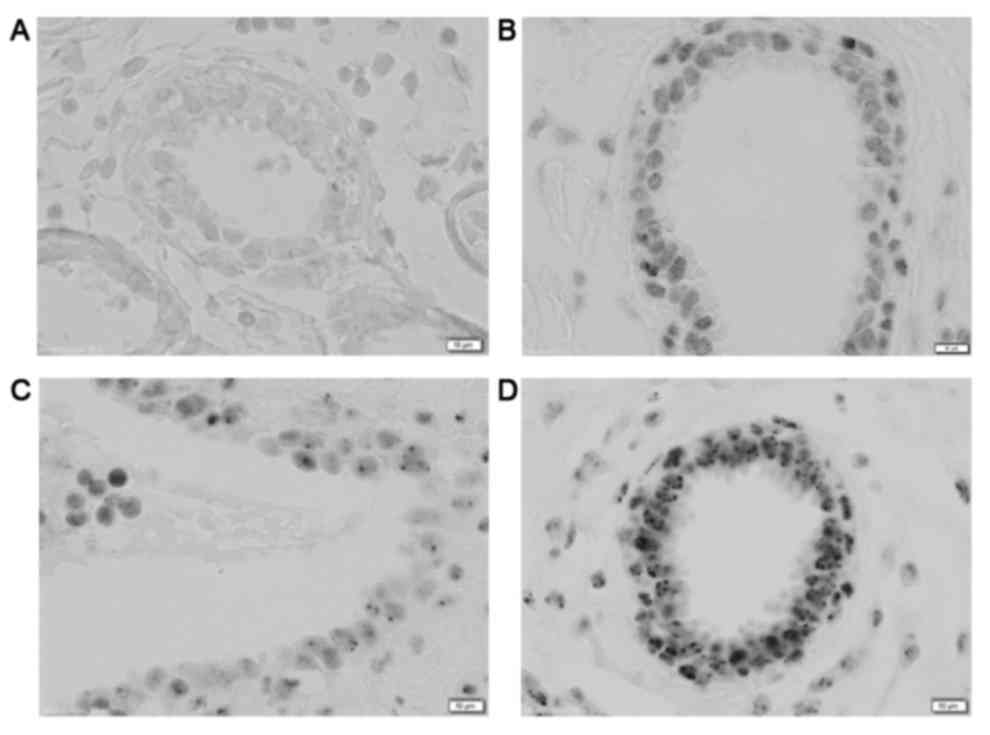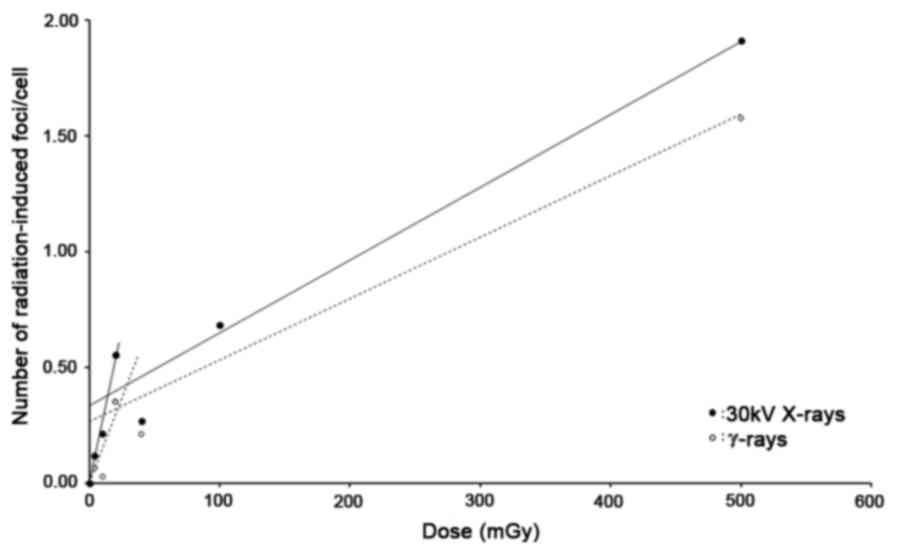|
1
|
Altobelli E and Lattanzi A: Breast cancer
in European Union: An update of screening programmes as of March
2014 (review). Int J Oncol. 45:1785–1792. 2014. View Article : Google Scholar : PubMed/NCBI
|
|
2
|
Klein R, Aichinger H, Dierker J, Jansen
JT, Joite-Barfuss S, Säbel M, Schulz-Wendtland R and Zoetelief J:
Determination of average glandular dose with modern mammography
units for two large groups of patients. Phys Med Biol. 42:651–671.
1997. View Article : Google Scholar : PubMed/NCBI
|
|
3
|
Brenner DJ, Doll R, Goodhead DT, Hall EJ,
Land CE, Little JB, Lubin JH, Preston DL, Preston RJ, Puskin JS, et
al: Cancer risks attributable to low doses of ionizing radiation:
Assessing what we really know. Proc Natl Acad Sci USA.
100:13761–13766. 2003. View Article : Google Scholar : PubMed/NCBI
|
|
4
|
Hendrick RE, Pisano ED, Averbukh A, Moran
C, Berns EA, Yaffe MJ, Herman B, Acharyya S and Gatsonis C:
Comparison of acquisition parameters and breast dose in digital
mammography and screen-film mammography in the American College of
Radiology Imaging Network digital mammographic imaging screening
trial. AJR Am J Roentgenol. 194:362–369. 2010. View Article : Google Scholar : PubMed/NCBI
|
|
5
|
The 2007 recommendations of the
International Commission on Radiological Protection: ICRP
publication 103. Ann ICRP. 37:1–332. 2007.
|
|
6
|
Averbeck D: Does scientific evidence
support a change from the LNT model for low-dose radiation risk
extrapolation? Health Phys. 97:493–504. 2009. View Article : Google Scholar : PubMed/NCBI
|
|
7
|
Heyes GJ, Mill AJ and Charles MW:
Mammography-oncogenecity at low doses. J Radiol Prot. 29:A123–A132.
2009. View Article : Google Scholar : PubMed/NCBI
|
|
8
|
Hunter N and Muirhead CR: Review of
relative biological effectiveness dependence on linear energy
transfer for low-LET radiations. J Radiol Prot. 29:5–21. 2009.
View Article : Google Scholar : PubMed/NCBI
|
|
9
|
Leenhouts HP and Chadwick KH: Dose-effect
relationships, epidemiological analysis and the derivation of low
dose risk. J Radiol Prot. 31:95–105. 2011. View Article : Google Scholar : PubMed/NCBI
|
|
10
|
Rothkamm K and Löbrich M: Evidence for a
lack of DNA double-strand break repair in human cells exposed to
very low x-ray doses. Proc Natl Acad Sci USA. 100:5057–5062. 2003.
View Article : Google Scholar : PubMed/NCBI
|
|
11
|
Bakkenist CJ and Kastan MB: Initiating
cellular stress responses. Cell. 118:9–17. 2004. View Article : Google Scholar : PubMed/NCBI
|
|
12
|
Grudzenski S, Raths A, Conrad S, Rübe CE
and Löbrich M: Inducible response required for repair of low-dose
radiation damage in human fibroblasts. Proc Natl Acad Sci USA.
107:14205–14210. 2010. View Article : Google Scholar : PubMed/NCBI
|
|
13
|
Colin C, Devic C, Noël A, Rabilloud M,
Zabot MT, Pinet-Isaac S, Giraud S, Riche B, Valette PJ,
Rodriguez-Lafrasse C and Foray N: DNA double-strand breaks induced
by mammographic screening procedures in human mammary epithelial
cells. Int J Radiat Biol. 87:1103–1112. 2011. View Article : Google Scholar : PubMed/NCBI
|
|
14
|
Amundson SA, Lee RA, Koch-Paiz CA, Bittner
ML, Meltzer P, Trent JM and Fornace AJ Jr: Differential responses
of stress genes to low dose-rate gamma irradiation. Mol Cancer Res.
1:445–452. 2003.PubMed/NCBI
|
|
15
|
Franco N, Lamartine J, Frouin V, Le Minter
P, Petat C, Leplat JJ, Libert F, Gidrol X and Martin MT: Low-dose
exposure to gamma rays induces specific gene regulations in normal
human keratinocytes. Radiat Res. 163:623–635. 2005. View Article : Google Scholar : PubMed/NCBI
|
|
16
|
Yang F, Stenoien DL, Strittmatter EF, Wang
J, Ding L, Lipton MS, Monroe ME, Nicora CD, Gristenko MA, Tang K,
et al: Phosphoproteome profiling of human skin fibroblast cells in
response to low- and high-dose irradiation. J Proteome Res.
5:1252–1260. 2006. View Article : Google Scholar : PubMed/NCBI
|
|
17
|
El-Saghire H, Thierens H, Monsieurs P,
Michaux A, Vandevoorde C and Baatout S: Gene set enrichment
analysis highlights different gene expression profiles in whole
blood samples X-irradiated with low and high doses. Int J Radiat
Biol. 89:628–638. 2013. View Article : Google Scholar : PubMed/NCBI
|
|
18
|
Kühne M, Urban G, Frankenberg D and
Löbrich M: DNA double-strand break misrejoining after exposure of
primary human fibroblasts to CK characteristic X rays, 29 kVp X
rays and 60Co gamma rays. Radiat Res. 164:669–676. 2005. View Article : Google Scholar : PubMed/NCBI
|
|
19
|
Depuydt J, Baert A, Vandersickel V,
Thierens H and Vral A: Relative biological effectiveness of
mammography X-rays at the level of DNA and chromosomes in
lymphocytes. Int J Radiat Biol. 89:532–538. 2013. View Article : Google Scholar : PubMed/NCBI
|
|
20
|
Mills CE, Thome C, Koff D, Andrews DW and
Boreham DR: The relative biological effectiveness of low-dose
mammography quality X rays in the human breast MCF-10A cell line.
Radiat Res. 183:42–51. 2015. View Article : Google Scholar : PubMed/NCBI
|
|
21
|
Fucic A and Gamulin M: Interaction between
ionizing radiation and estrogen: What we are missing? Med
Hypotheses. 77:966–969. 2011. View Article : Google Scholar : PubMed/NCBI
|
|
22
|
Shao C, Folkard M, Held KD and Prise KM:
Estrogen enhanced cell-cell signalling in breast cancer cells
exposed to targeted irradiation. BMC Cancer. 8:1842008. View Article : Google Scholar : PubMed/NCBI
|
|
23
|
Liehr JG: Genotoxicity of the steroidal
oestrogens oestrone and oestradiol: Possible mechanism of uterine
and mammary cancer development. Hum Reprod Update. 7:273–281. 2001.
View Article : Google Scholar : PubMed/NCBI
|
|
24
|
Cavalieri E, Chakravarti D, Guttenplan J,
Hart E, Ingle J, Jankowiak R, Muti P, Rogan E, Russo J, Santen R
and Sutter T: Catechol estrogen quinones as initiators of breast
and other human cancers: Implications for biomarkers of
susceptibility and cancer prevention. Biochim Biophys Acta.
1766:63–78. 2006.PubMed/NCBI
|
|
25
|
Rogakou EP, Pilch DR, Orr AH, Ivanova VS
and Bonner WM: DNA double-stranded breaks induce histone H2AX
phosphorylation on serine 139. J Biol Chem. 273:5858–5868. 1998.
View Article : Google Scholar : PubMed/NCBI
|
|
26
|
Rothkamm K and Horn S: gamma-H2AX as
protein biomarker for radiation exposure. Ann Ist Super Sanita.
45:265–271. 2009.PubMed/NCBI
|
|
27
|
Averbeck D: Non-targeted effects as a
paradigm breaking evidence. Mutat Res. 687:7–12. 2010. View Article : Google Scholar : PubMed/NCBI
|
|
28
|
Beyreuther E, Dörr W, Lehnert A, Lessmann
E and Pawelke J: Relative biological effectiveness of 25 and 10 kV
X-rays for the induction of chromosomal aberrations in two human
mammary epithelial cell lines. Radiat Environ Biophys. 48:333–340.
2009. View Article : Google Scholar : PubMed/NCBI
|
|
29
|
Beyreuther E, Lessmann E, Pawelke J and
Pieck S: DNA double-strand break signalling: X-ray energy
dependence of residual co-localised foci of gamma-H2AX and 53BP1.
Int J Radiat Biol. 85:1042–1050. 2009. View Article : Google Scholar : PubMed/NCBI
|
|
30
|
Lehnert A, Lessmann E, Pawelke J and Dörr
W: RBE of 25 kV X-rays for the survival and induction of
micronuclei in the human mammary epithelial cell line MCF-12A.
Radiat Environ Biophys. 45:253–260. 2006. View Article : Google Scholar : PubMed/NCBI
|
|
31
|
Roy R, Chun J and Powell SN: BRCA1 and
BRCA2: Different roles in a common pathway of genome protection.
Nat Rev Cancer. 12:68–78. 2011. View
Article : Google Scholar : PubMed/NCBI
|
|
32
|
van Oorschot B, Hovingh S, Dekker A,
Stalpers LJ and Franken NA: Predicting radiosensitivity with
gamma-H2AX foci assay after single high-dose-rate and pulsed
dose-rate ionizing irradiation. Radiat Res. 185:190–198. 2016.
View Article : Google Scholar : PubMed/NCBI
|
|
33
|
Beels L, Bacher K, De Wolf D, Werbrouck J
and Thierens H: gamma-H2AX foci as a biomarker for patient X-ray
exposure in pediatric cardiac catheterization: Are we
underestimating radiation risks? Circulation. 120:1903–1909. 2009.
View Article : Google Scholar : PubMed/NCBI
|
|
34
|
Beels L, Werbrouck J and Thierens H: Dose
response and repair kinetics of gamma-H2AX foci induced by in vitro
irradiation of whole blood and T-lymphocytes with X- and
gamma-radiation. Int J Radiat Biol. 86:760–768. 2010. View Article : Google Scholar : PubMed/NCBI
|
|
35
|
Groesser T, Cooper B and Rydberg B: Lack
of bystander effects from high-LET radiation for early cytogenetic
end points. Radiat Res. 170:794–802. 2008. View Article : Google Scholar : PubMed/NCBI
|
|
36
|
Azzam EI, de Toledo SM and Little JB:
Direct evidence for the participation of gap junction-mediated
intercellular communication in the transmission of damage signals
from alpha-particle irradiated to nonirradiated cells. Proc Natl
Acad Sci USA. 98:473–478. 2001. View Article : Google Scholar : PubMed/NCBI
|
|
37
|
Azzam EI, de Toledo SM and Little JB:
Stress signaling from irradiated to non-irradiated cells. Curr
Cancer Drug Targets. 4:53–64. 2004. View Article : Google Scholar : PubMed/NCBI
|
|
38
|
Hanot M, Hoarau J, Carrière M, Angulo JF
and Khodja H: Membrane-dependent bystander effect contributes to
amplification of the response to alpha-particle irradiation in
targeted and nontargeted cells. Int J Radiat Oncol Biol Phys.
75:1247–1253. 2009. View Article : Google Scholar : PubMed/NCBI
|
|
39
|
Mothersill C and Seymour C:
Radiation-induced bystander effects: Past history and future
directions. Radiat Res. 155:759–767. 2001. View Article : Google Scholar : PubMed/NCBI
|
|
40
|
Zhou H, Suzuki M, Geard CR and Hei TK:
Effects of irradiated medium with or without cells on bystander
cell responses. Mutat Res. 499:135–141. 2002. View Article : Google Scholar : PubMed/NCBI
|
|
41
|
Lisowska H, Wegierek-Ciuk A, Banasik-Nowak
A, Braziewicz J, Wojewodzka M, Wojcik A and Lankoff A: The
dose-response relationship for dicentric chromosomes and γ-H2AX
foci in human peripheral blood lymphocytes: Influence of
temperature during exposure and intra- and inter-individual
variability of donors. Int J Radiat Biol. 89:191–199. 2013.
View Article : Google Scholar : PubMed/NCBI
|
|
42
|
Dang L, Lisowska H, Manesh SS, Sollazzo A,
Deperas-Kaminska M, Staaf E, Haghdoost S, Brehwens K and Wojcik A:
Radioprotective effect of hypothermia on cells-a multiparametric
approach to delineate the mechanisms. Int J Radiat Biol.
88:507–514. 2012. View Article : Google Scholar : PubMed/NCBI
|
















